Although he was not a chess composer, let's have a thought for
Ken Whyld, the chess historian (6 March 1926 – 11 July 2003) and
The Ken Whyld Association named after him and in his memory.
Adolf Wilhelm Fritsch (06-03-1897 - 31-07-1972) German composer
Fritsch, Adolf Wilhelm
2575 Schach 03/1957
Prize
Show Solution1. Bf3! Bd2 2. Rh1+ Sxh1 3. Qxg3+ Sxg3+ 4. Kg4 h5#
A hidden solution.
Herbert Angeli (06-03-1926) Swiss composer
Herbert Angeli published mainly heterodox problems. His helpmates feature difficult themes such as white move cycles, such as
P0504205 or
P0504307.
Here is an example of what we call today
HOTF (Helpmate Of The Future).
Angeli, Herbert
Memorial Bikos 1990-91
Special Prize
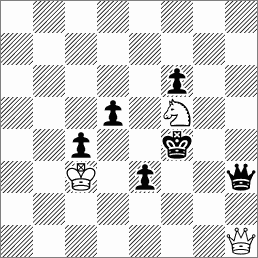
Show Solution1.Qg2 Qh4+ [A] 2.Kf3 Sd4# [B]
1.Qf3 Qh2+ [C] 2.Ke4 Sd6# [D]
1.Qh5 Sd4 [B] 2.Qe5 Qh4# [A]
1.Ke5 Sd6 [D] 2.Qe6 Qh2# [C]
Anticipatory self-block, reciprocal change of white moves AB-BA, CD-DC. Model mates.
For direct mate lovers we also present a twomover with three changed mates from set play to real play:
Angeli, Herbert
Schweizerische Arbeiter-Schachzeitung, 1962
2
nd Prize

Show SolutionSet play:
1...Rxe5[a]/Rd3/Rxc3/Rf3 2.e4#[A]
1...Bh4/Bf2/Be1/Bf4/Bxe5[b] 2.Sf4#[B]
1...dxe5[c] 2.Rd8#[C]
1...b4 2.c4#
1...Sc5 2.Sc7#
1.Sg5! (2.Qxd6#)
1...Rxe5[a] 2.Qd3#[E]
1...Bxe5[b] 2.Qxg8#[D]
1...dxe5[c] 2.Qc6#[F]
1...Kxe5 2.Sh3#
1...Be6 2.Qxe6#
Changed mates, Anderssen, flight-giving key.
[
Anderssen: A white piece A intercepts another white piece, Black moves, then A moves again giving an indirect check.]
Jochen Lehmensick did not compose too much. We learnt from him that Pickaninny can be shown in miniature - quite an achievement for a 15 years old composer:
Lehmensick, Jochen
Die Schwalbe, 1956

Show Solution1.Kc4 ! (2.axb7 ZZ 2...Ka4 3.Ra2#)
1...b5+ 2.Kc3 ZZ 2...Ka4 3.Ra2#
1...b6 2.b5 ZZ 2...Ka4 3.Ra2#
1...bxa6 2.Sc6-a5 ZZ 2...Ka4 3.Ra2#
1...bxc6 2.a7 (3.a8=Q/R#)
Pickaninny, miniature.
Viorel Diaconu (06-03-1942 - 31-07-1999) Romanian composer
Another pleasant miniature with 4 distinct mates:
Diaconu, Viorel
De Waarheid, 1967
1
st Prize
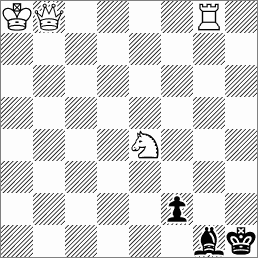
Show Solution1.Qb2! ZZ
1...Kh2 2.Qh8#
1...f1Q/f1B 2.Sg3#
1...f1R 2.Sg3#/Qg2#
1...f1S 2.Qg2#
1...Bh2 2.Sxf2#
Flight-giving key, miniature.
Gábor Zoltán Tar (06-03-1943) Hungarian composer
Gábor Tar came recently back to composition after a 30-year break. He started his career with two prizewinners in 1975 (
P0505993,
YACPDBid=38744).
Gábor recently published also a booklet on the occasion of his 70th birthday. This book "
Logika & Harmónia" (in Hungarian, but with many problems) can be downloaded from
here and the introduction translated in English,
here.
For the blog we will quote a charming Circe miniature:
Tar, Gábor
1486 Rozmaitosci szachowe, 12/2011
4. Malgorzata Grudzinska MT
3
rd Prize
Show Solution1. Qe1 Rg3 2. Qe2 Rg1#
1. Qd5+ Kxb4[+bPb7] 2. Qg2 Re1#
1. Qe2 Rd3 2. Ke1 Rd1#
1. Re2 Rf3+ 2. Ke1 Rf1#
Chameleon echo mates.
Paul Valois is better known as an excellent writer in
The Problemist, where he skillfully managed several columns. His intense activity in former PCCC, supporting John Rice, did not leave him too much time for composing.
Valois, Paul Stedman
McWilliam Ty. 1964
3
rd Prize
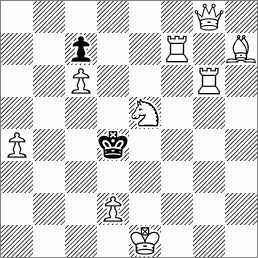
Show Solution1.Sd3! ZZ
1...Kxd3 2.Rg4#
1...Kd5 2.Rf4#
1...Kc4 2.Rd7#
1...Ke4 2.Rd6#
Shows black King cross, more difficult theme than the black King star.
André Hazebrouck (06-03-1918 - 20-09-2002) French composer
André Hazebrouck was one of leading's classic retro experts and was the retro editor of French magazine Europe Echecs. He was the first to show the retro-opposition of free knights (see for instance
his excellent Die Schwalbe 1st prizewinner with the extensive solution given in PDB's
P0000265).
For the blog we selected the following retro problem:
Hazebrouck, André
Шахматы в СССР 1981
1
st-2
nd Prize
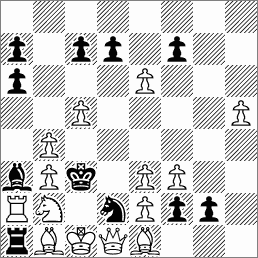
Show SolutionWe shall quote Henrik Juel's excellent comments from PDB (
P0004381):
1... Rxb1#, not 1.Bxd2?
-1.d5xSe6 Sd8 -2.d4 Sb7 -3.c4 Sc5 -4.h4 Sa4 -5.Sd3 Sb2 -6.Sf4 g3 -7.Sh5 g4 -8.Sg3xPh5 g5 -9.Sf1 g6 -10.Bf5 Sb1 -11.Sd2 g7 -12.Bh3 h6 -13.Bf1 h7 -14.g2xBf3 Bb7 -15.d3 f3 etc.
The main points of the retroplay are fairly obvious: wPe6 uncaptures a sS that releases wSb2 that releases sSd2 that releases wLb1 that retracts to f1. But the details are hard to unravel:
- Is sS uncaptured on e6 or e5, and by dxe or fxe?
- Is the sPh uncaptured by wL or wS or not at all?
- Should the square c4 be used by a S?
The dualistic path of sS from e6 to b2 contributes to the difficulty. With wPc5,h5 moved to c4,h4 in the diagram, the retroplay would be more precise, but the tries would evaporate. Great solving object.




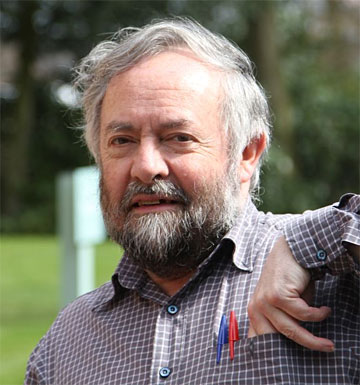
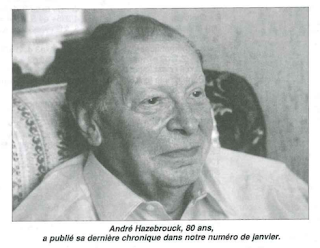
No comments:
Post a Comment